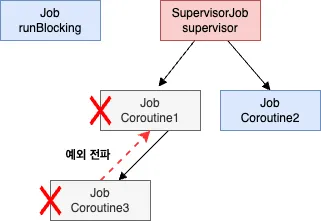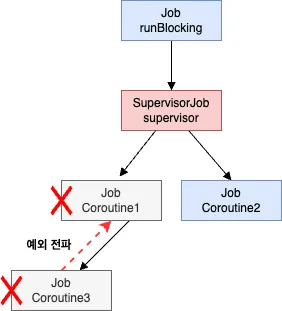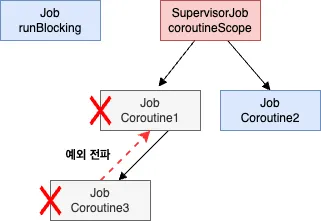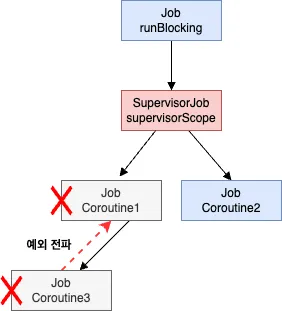Coroutine - 예외 처리(1): 예외 전파 제한 방법
in DEV on Kotlin, Coroutine, Supervisor-job, Supervisor-scope
구조화된 동시성이라는 코루틴의 핵심 개념은 예외 전파 방식에 깊이 관여한다.
이 포스트에서는 아래 내용에 대해 알아본다.
- 코루틴이 예외를 전파하는 방식
- 예외 전파를 막거나 범위를 제한하는 방법
소스는 github 에 있습니다.
목차
- 1. 코루틴의 예외 전파
- 2. 예외 전파 제한 3가지 방법
- 참고 사이트 & 함께 보면 좋은 사이트
1. 코루틴의 예외 전파
코루틴은 동시성을 안전하게 다룰 수 있도록 구조화된 동시성 개념을 따른다.
이 구조 덕분에 코루틴이 예외를 발생시키면 단지 해당 코루틴만 종료되는 것이 아니라 전체 구조에 영향을 미치는 예외 전파가 발생한다.
여기서는 예외가 어떻게 전파되고, 왜 예외 하나가 전체 코루틴 구조를 중단시킬 수 있는지에 대해 알아본다.
코루틴 내부에서 예외가 발생하면 해당 코루틴은 즉시 취소되고, 부모 코루틴으로 예외가 전파된다.
부모 코루틴에서도 예외를 처리하지 않으면 상위 코루틴까지 전파되며, 최종적으로 루트 코루틴(runBlocking 등)까지 도달할 수 있다.
또한 코루틴의 구조상, 한 코루틴의 취소는 그 자식 코루틴들까지 영향을 미치므로 예외 하나로 전체 코루틴 트리가 취소될 수 있다.
예외 하나가 전체 코루틴을 취소시키는 예시
package chap08
import kotlinx.coroutines.CoroutineName
import kotlinx.coroutines.delay
import kotlinx.coroutines.launch
import kotlinx.coroutines.runBlocking
fun main() = runBlocking<Unit> {
launch(context = CoroutineName("Coroutine1")) {
launch(context = CoroutineName("Coroutine3")) {
throw Exception("예외 발생")
}
delay(100L)
println("[${Thread.currentThread().name}] 코루틴 실행")
}
launch(context = CoroutineName("Coroutine2")) {
delay(100L)
println("[${Thread.currentThread().name}] 코루틴 실행")
}
delay(1000L)
}
Exception in thread "main" java.lang.Exception: 예외 발생
at chap08.Code01Kt$main$1$1$1.invokeSuspend(Code01.kt:11)
at kotlin.coroutines.jvm.internal.BaseContinuationImpl.resumeWith(ContinuationImpl.kt:33)
at kotlinx.coroutines.DispatchedTask.run(DispatchedTask.kt:100)
at kotlinx.coroutines.EventLoopImplBase.processNextEvent(EventLoop.common.kt:263)
at kotlinx.coroutines.BlockingCoroutine.joinBlocking(Builders.kt:95)
at kotlinx.coroutines.BuildersKt__BuildersKt.runBlocking(Builders.kt:69)
at kotlinx.coroutines.BuildersKt.runBlocking(Unknown Source)
at kotlinx.coroutines.BuildersKt__BuildersKt.runBlocking$default(Builders.kt:47)
at kotlinx.coroutines.BuildersKt.runBlocking$default(Unknown Source)
at chap08.Code01Kt.main(Code01.kt:8)
at chap08.Code01Kt.main(Code01.kt)
- runBlocking 은 루트 코루틴이다.
Coroutine1, 2 는 자식 코루틴이고, Coroutine3 은 Coroutine1 의 자식 코루틴이다.
- Coroutine3 에서 발생한 예외가 처리되지 않아 Coroutine1 을 통해 runBlocking 까지 전달됨
- 루트 코루틴(runBlocking) 이 취소됨
- 하위 코루틴들인 Coroutine1, 2 도 함께 취소됨
- 결국 모든 코루틴이 실행되지 못하여 예외 로그만 출력되고, “코루틴 실행” 메시지는 보이지 않음
구조화된 동시성은 안전한 자원 정리를 위한 장치이지만, 명시적 예외 처리가 없으면 전체 작업이 중단될 수 있다.
이러한 문제를 막기 위해 코루틴은 전파되는 예외를 제한하거나 격리하는 방법을 제공한다.
2. 예외 전파 제한 3가지 방법
특정 코루틴에서 발생한 예외가 전체에 영향을 미치지 않게 하는 방법에 대해 알아본다.
2.1. Job 객체로 예외 전파 제한
Job()을 이용한 예외 전파 제한은 구조화를 깨뜨림으로써 구현되는데 이는 취소 전파까지 제한되고, 정상적인 자원 정리의 흐름도 함께 끊어진다.
따라서 해당 코드를 참고만 할 것
2.1.1. Job 객체로 구조화 깨기
코루틴은 예외를 부모 Job 객체를 통해 전파한다.
따라서 부모와의 구조화 관계를 인위적으로 끊으면, 예외가 상위로 전파되지 않게 할 수 있다.
부모 코루틴과의 구조화를 깨는 방법은 새로운 Job 객체를 만들어 구조화를 깨고 싶은 코루틴을 연결하면 된다.
package chap08
import kotlinx.coroutines.CoroutineName
import kotlinx.coroutines.Job
import kotlinx.coroutines.delay
import kotlinx.coroutines.launch
import kotlinx.coroutines.runBlocking
fun main() = runBlocking<Unit> {
launch(CoroutineName("Parent Coroutine")) {
// 새로운 Job 객체를 만들어 Coroutine1에 연결
launch(CoroutineName("Coroutine1") + Job()) {
launch(CoroutineName("Coroutine3")) {
throw Exception("예외 발생")
}
delay(100L)
println("[${Thread.currentThread().name}] 코루틴 실행")
}
launch(CoroutineName("Coroutine2")) {
delay(100L)
println("[${Thread.currentThread().name}] 코루틴 실행")
}
}
delay(1000L)
}
Exception in thread "main @Coroutine1#3" java.lang.Exception: 예외 발생
at chap08.Code01Kt$main$1$1$1$1.invokeSuspend(Code01.kt:14)
at kotlin.coroutines.jvm.internal.BaseContinuationImpl.resumeWith(ContinuationImpl.kt:33)
at kotlinx.coroutines.DispatchedTask.run(DispatchedTask.kt:100)
at kotlinx.coroutines.EventLoopImplBase.processNextEvent(EventLoop.common.kt:263)
at kotlinx.coroutines.BlockingCoroutine.joinBlocking(Builders.kt:95)
at kotlinx.coroutines.BuildersKt__BuildersKt.runBlocking(Builders.kt:69)
at kotlinx.coroutines.BuildersKt.runBlocking(Unknown Source)
at kotlinx.coroutines.BuildersKt__BuildersKt.runBlocking$default(Builders.kt:47)
at kotlinx.coroutines.BuildersKt.runBlocking$default(Unknown Source)
at chap08.Code01Kt.main(Code01.kt:9)
at chap08.Code01Kt.main(Code01.kt)
Suppressed: kotlinx.coroutines.internal.DiagnosticCoroutineContextException: [CoroutineName(Coroutine1), CoroutineId(3), "Coroutine1#3":StandaloneCoroutine{Cancelling}@457e2f02, BlockingEventLoop@5c7fa833]
[main @Coroutine2#4] 코루틴 실행
- Coroutine1 은
Job()을 통해 부모 코루틴과의 구조화를 끊었기 때문에, 그 내부 자식인 Coroutine3 의 예외가 Parent Coroutine 까지 전파되지 않음 - 따라서 Coroutine2 는 예외의 영향을 받지 않고 정상 실행
구조화를 의도적으로 끊으면 예외 전파가 차단되므로, 전체 작업 중단을 방지할 수 있다.
구조화를 깨뜨리는 것은 특별한 상황에서만!
일반적으로 구조화된 동시성의 원칙을 지키는 것이 안전하다.
Job()을 사용해 구조를 끊는 방식은 의도적으로 분리된 작업을 실행하거나, 독립적인 생명주기를 부여할 때만 사용해야 한다.
2.1.2. Job 객체를 사용한 예외 전파의 한계
Job() 을 이용한 구조화 깨기 방식은 예외 전파 뿐 아니라 취소 전파도 제한한다.
일반적으로 코루틴은 부모가 취소되면 자식도 함께 취소된다.
하지만 새로운 Job() 객체를 생성하면, 해당 코루틴은 부모의 자식이 아니게 되므로 취소 전파가 일어나지 않는다.
취소가 전파되지 않는 예시
package chap08
import kotlinx.coroutines.CoroutineName
import kotlinx.coroutines.Job
import kotlinx.coroutines.delay
import kotlinx.coroutines.launch
import kotlinx.coroutines.runBlocking
fun main() = runBlocking<Unit> {
val parentJob = launch(context = CoroutineName("parentCoroutine")) {
launch(context = CoroutineName("Coroutine1") + Job()) {
launch(context = CoroutineName("Coroutine3")) {
delay(100L)
println("[${Thread.currentThread().name}] 코루틴 실행")
}
delay(100L)
println("[${Thread.currentThread().name}] 코루틴 실행")
}
launch(context = CoroutineName("Coroutine2")) {
delay(100L)
println("[${Thread.currentThread().name}] 코루틴 실행")
}
}
delay(20L) // 코루린들이 모두 생성될 때까지 대기
parentJob.cancel() // ParentCoroutine 에 취소 요청
delay(1000L)
}
[main @Coroutine1#3] 코루틴 실행
[main @Coroutine3#5] 코루틴 실행
- Coroutine1은
Job()을 사용해 구조화를 끊었기 때문에 ParentCoroutine 의 자식이 아님 - 따라서 ParentCoroutine 이
cancel()되더라도 Coroutine1, 3 은 취소되지 않고 정상 실행됨 - 반면, Coroutine2 는 구조화된 자식이므로 취소 전파에 의해 실행되지 않음
구조화를 깨뜨리는 방식의 한계
이러한 방식은 예외 전파와 취소 전파 모두를 차단하기 때문에 정상적인 자원 정리 흐름도 함께 끊어질 수 있다.
즉, ParentCoroutine 이 중단되었을 때 하위 작업도 함께 정리되어야 안정적인데, 구조화가 깨져있으면 오히려 비동기 작업의 안정성을 해칠 수 있다.
구조화를 유지하면서도 예외 전파만 하는 방식이 더 안전하다.
구조화를 유지하면 예외만 제한하고 싶다면 코루틴 라이브러리에서 제공하는 SupervisorJob 객체를 사용하면 된다.
이는 구조화된 코루틴 계층을 유지하면서도 자식의 실패가 부모나 형제 코루틴에 영향을 주지 않도록 해준다.
2.2. SupervisorJob 객체를 사용한 예외 전파 제한
SupervisorJob 은 구조화된 동시성은 유지하면서도 자식 코루틴 간의 예외 전파를 막을 수 있는 Job 이다.
즉, 하나의 자식 코루틴에서 예외가 발생하더라도 다른 자식 코루틴에게 영향을 주지 않게 할 수 있다.
SupervisorJob 시그니처
public fun SupervisorJob(parent: Job? = null) : CompletableJob = SupervisorJobImpl(parent)
parent인자를 생략하면 루트SupervisorJob으로 동작parent인자에 상위 Job 을 넣으면 구조화를 유지하면서 사용 가능
<SupervisorJob 를 사용하는 이유와 주의점>
- 역할
- 자식 코루틴 간 예외 전파 방지
- 구조화 유지
SupervisorJob(parent)사용 시 가능
- 취소 전파
- 부모 Job 이 취소되면
SupervisorJob도 취소됨
- 부모 Job 이 취소되면
- 완료 처리
complete()호출 필요
SupervisorJob 은 코루틴 간 결합을 느슨하게 유지하면서 안정성을 높이는 전략이다. 특히 UI 작업, 네트워크 요청, 로그 기록 작업 등 실패해도 다른 작업에 영향을 주면 안되는 작업에 유용하다.
2.2.1. 구조화를 유지하지 않는 SupervisorJob 잘못된 사용
SupervisorJob 객체로 예외를 전파시키지 않는 예시 (구조화를 유지하지 않음)
package chap08
import kotlinx.coroutines.CompletableJob
import kotlinx.coroutines.CoroutineName
import kotlinx.coroutines.SupervisorJob
import kotlinx.coroutines.delay
import kotlinx.coroutines.launch
import kotlinx.coroutines.runBlocking
fun main() = runBlocking<Unit> {
val supervisor: CompletableJob = SupervisorJob()
launch(context = CoroutineName("Coroutine1") + supervisor) { // supervisor 객체 사용
launch(context = CoroutineName("Coroutine3")) {
throw Exception("예외 발생")
}
delay(100L)
println("[${Thread.currentThread().name}] 코루틴 실행")
}
launch(context = CoroutineName("Coroutine2") + supervisor) { // supervisor 객체 사용
delay(100L)
println("[${Thread.currentThread().name}] 코루틴 실행")
}
delay(1000L) // 1초 뒤 전체 코루틴 종료
}

Exception in thread "main @Coroutine1#2" java.lang.Exception: 예외 발생
at chap08.Code04Kt$main$1$1$1.invokeSuspend(Code04.kt:14)
// ...
Suppressed: kotlinx.coroutines.internal.DiagnosticCoroutineContextException: [CoroutineName(Coroutine1), CoroutineId(2), "Coroutine1#2":StandaloneCoroutine{Cancelling}@39aeed2f, BlockingEventLoop@724af044]
[main @Coroutine2#3] 코루틴 실행
Process finished with exit code 0
- Coroutine3 → 예외 발생 → Coroutine1 취소됨
- 하지만 Coroutine2 는 영향을 받지 않고 정상 실행됨
SupervisorJob 덕분에 자식 간 예외 전파가 차단된 것이다.
⚠️ 하지만 이 코드는 구조화를 깨뜨리는 문제가 있다.
위 코드는 SupervisorJob 이 runBlocking 이 생성한 Job 과 구조화되어 있지 않기 때문에 runBlocking 이 취소되더라도 SupervisorJob 하위 코루틴은 취소되지 않을 수 있다.
2.2.2. 구조화를 유지한 SupervisorJob 사용
구조화를 깨지 않고 SupervisorJob 을 사용하기 위해서는 SupervisorJob 의 인자로 부모 Job 객체를 넘기면 된다.
package chap08
import kotlinx.coroutines.CompletableJob
import kotlinx.coroutines.CoroutineName
import kotlinx.coroutines.Job
import kotlinx.coroutines.SupervisorJob
import kotlinx.coroutines.delay
import kotlinx.coroutines.launch
import kotlinx.coroutines.runBlocking
fun main() = runBlocking<Unit> {
// supervisorJob 의 parent 로 runBlocking 이 호출되어 만들어진 Job 객체 설정
val supervisor: CompletableJob = SupervisorJob(parent = this.coroutineContext[Job])
launch(context = CoroutineName("Coroutine1") + supervisor) { // supervisor 객체 사용
launch(context = CoroutineName("Coroutine3")) {
throw Exception("예외 발생")
}
delay(100L)
println("[${Thread.currentThread().name}] 코루틴 실행")
}
launch(context = CoroutineName("Coroutine2") + supervisor) { // supervisor 객체 사용
delay(100L)
println("[${Thread.currentThread().name}] 코루틴 실행")
}
// supervisor 완료 처리 (이게 없으면 전체 코루틴 종료가 되지 않음)
supervisor.complete()
}
- 구조화 유지
SupervisorJob이 runBlocking 의 Job 을 부모로 가지므로 전체 작업 구조 내에서 관리된다.
- 자식 간 예외 차단
- 예외는 Coroutine1 만 취소시키고, Coroutine2 는 영향이 없다.
- 명시적 완료 처리
- SupervisorJob() 을 통해 생성된 Job 객체는 자동 완료 처리되지 않으므로 supervisor.complete() 호출이 필요하다.
마지막에 supervisor.complete() 를 실행하여 SupervisorJob 에 대해 명시적으로 완료 처리를 한다.
SupervisorJob() 을 통해 생성된 Job 객체는 Job() 을 통해 생성된 Job 객체와 같이 자동으로 완료처리 되지 않는다.

Exception in thread "main @Coroutine1#2" java.lang.Exception: 예외 발생
at chap08.Code05Kt$main$1$1$1.invokeSuspend(Code05.kt:17)
// ...
Suppressed: kotlinx.coroutines.internal.DiagnosticCoroutineContextException: [CoroutineName(Coroutine1), CoroutineId(2), "Coroutine1#2":StandaloneCoroutine{Cancelling}@c038203, BlockingEventLoop@cc285f4]
[main @Coroutine2#3] 코루틴 실행
Process finished with exit code 0
2.2.3. SupervisorJob 을 CoroutineScope 와 함께 사용
SupervisorJob 을 CoroutineScope 와 함께 사용하면 스코프 전체를 구조화된 단위로 유지하면서도 자식 간의 예외 전파를 효과적으로 차단할 수 있다.
CoroutineScope(context = SupervisorJob()) 처럼 생성하면 이 스코프 내에서 launch() 되는 모든 코루틴은 형제 간 예외에 영향을 받지 않는다.
package chap08
import kotlinx.coroutines.CoroutineName
import kotlinx.coroutines.CoroutineScope
import kotlinx.coroutines.SupervisorJob
import kotlinx.coroutines.delay
import kotlinx.coroutines.launch
import kotlinx.coroutines.runBlocking
fun main() = runBlocking {
// CoroutineContext 에 SupervisorJob() 객체 설정
val coroutineScope = CoroutineScope(context = SupervisorJob())
coroutineScope.apply {
launch(context = CoroutineName("Coroutine1")) {
launch(context = CoroutineName("Coroutine3")) {
throw Error("예외 발생")
}
delay(100L)
println("[${Thread.currentThread().name}] 코루틴 실행")
}
launch(context = CoroutineName("Coroutine2")) {
delay(100L)
println("[${Thread.currentThread().name}] 코루틴 실행")
}
}
delay(1000L)
}

Exception in thread "DefaultDispatcher-worker-1 @Coroutine1#2" java.lang.Error: 예외 발생
at chap08.Code06Kt$main$1$1$1$1.invokeSuspend(Code06.kt:17)
// ...
Suppressed: kotlinx.coroutines.internal.DiagnosticCoroutineContextException: [CoroutineName(Coroutine1), CoroutineId(2), "Coroutine1#2":StandaloneCoroutine{Cancelling}@597a693c, Dispatchers.Default]
[DefaultDispatcher-worker-1 @Coroutine2#3] 코루틴 실행
Process finished with exit code 0
- Coroutine3 → 예외 발생 → Coroutine1 만 취소
- Coroutine2 는 영향받지 않고 정상 실행
- CoroutineScope 에 설정된 SupervisorJob 이 형제 코루틴 간 예외 전파 차단
<SupervisorJob 을 CoroutineScope 와 함께 사용할 때의 장점>
- 스코프 구조화
- 전체 작업을 하나의 스코프로 관리
- 자식 간 예외 전파 제한
- 하나의 자식이 실패해도 다른 자식은 영향 없음
- 실용성
- UI, 병렬 처리, 안정성이 중요한 상황에서 유용
이 방식은 병렬로 여러 작업을 수행하면서 하나가 실패하더라도 나머지를 계속 유지하고 싶을 때 사용한다.
예) 병렬 API 요청, 파일 업로드, 알림 전송 등 실패 허용 가능한 작업들
2.2.4. SupervisorJob 을 사용할 때 흔히 하는 실수
SupervisorJob 은 자식 코루틴 간의 예외 전파를 방지할 수 있는 훌륭한 도구이다.
하지만 코루틴 빌더 함수의 context 인자에 직접 SupervisorJob() 을 넘기는 방식은 의도와 다르게 동작하여 오히려 전체 코루틴 트리의 취소를 유발할 수 있다.
잘못 사용된 예시
package chap08
import kotlinx.coroutines.CoroutineName
import kotlinx.coroutines.SupervisorJob
import kotlinx.coroutines.delay
import kotlinx.coroutines.launch
import kotlinx.coroutines.runBlocking
fun main() = runBlocking<Unit> {
launch(context = CoroutineName("ParentCoroutine") + SupervisorJob()) {
launch(context = CoroutineName("Coroutine1")) {
launch(context = CoroutineName("Coroutine3")) {
throw Exception("예외 발생")
}
delay(100L)
println("[${Thread.currentThread().name}] 코루틴 실행")
}
launch(context = CoroutineName("Coroutine2")) {
delay(100L)
println("[${Thread.currentThread().name}] 코루틴 실행")
}
}
delay(1000L)
}
Exception in thread "main @Coroutine2#4" java.lang.Exception: 예외 발생
at chap08.Code07Kt$main$1$1$1$1.invokeSuspend(Code07.kt:14)
// ...
Suppressed: kotlinx.coroutines.internal.DiagnosticCoroutineContextException: [CoroutineName(ParentCoroutine), CoroutineId(2), "ParentCoroutine#2":StandaloneCoroutine{Cancelling}@8bd1b6a, BlockingEventLoop@18be83e4]
Process finished with exit code 0
- launch(context = SupervisorJob()) 으로 생성된 ParentCoroutine 은 실제로는
SupervisorJob을 부모로 하는 새로운 Job 을 갖는 일반적인 코루틴이 된다. - 즉, Coroutine3 에서 발생한 예외는 Coroutine1 → ParentCoroutine 까지 전파되어 ParentCoroutine 이 취소되고, 그 하위 코루틴인 Coroutine2 도 함께 취소된다.
- 이 때
SupervisorJob은 최상위에 존재하지만 아무 역할도 하지 못한다.

<SupervisorJob 사용 시 주의할 점>
| 항목 | 잘못된 사용 | 올바른 사용 |
|---|---|---|
| 사용 위치 | launch(context = SupervisorJob()) | CoroutineScope(context = SupervisorJob()) 또는 SupervisorJob(parent) |
| 결과 | 중간에 새로운 Job 이 생성되어 예외 전파 차단 실패 | 구조화 유지 + 자식 간 예외 차단 |
위 그림처럼 SupervisorJob 이 고립됨 | SupervisorJob 이 상위 Job 에 정확히 연결됨 |
SupervisorJob 를 사용하는 가장 안전한 방식은 CoroutineScope(context = SupervisorJob()) 으로 스코프를 명시적으로 만들거나, SupervisorJob(parent) 로 구조화된 상위 Job 에 연결하는 것이다.
2.3. supervisorScope() 를 사용한 예외 전파 제한
코루틴의 예외 전파를 제한하는 세 번째 방법은 supervisorScope() 함수를 사용하는 것이다.
supervisorScope() 의 목적은 구조화된 동시성을 유지하면서도 자식 코루틴 간 예외 전파를 막는 것이다.
supervisorScope() 함수는 내부적으로 SupervisorJob 을 포함한 CoroutineScope 를 생성한다.
이 SupervisorJob 은 supervisorScope() 를 호출한 코루틴의 Job 을 부모(여기서는 runBlocking)로 가지며, 이를 통해 구조화를 유지하면서도 자식 코루틴 간의 예외 전파를 제한할 수 있다.
즉, 별도의 설정 없이도 supervisorScope() 를 사용하면 구조화된 동시성을 깨지 않고, 각 자식 코루틴의 실패가 다른 자식에게 영향을 주지 않도록 설계할 수 있다.
또한 supervisorScope() 는 블록 내부 코드와 자식 코루틴이 모두 완료되면 자신의 SupervisorJob 이 자동으로 완료 처리되도록 보장한다.
package chap08
import kotlinx.coroutines.CoroutineName
import kotlinx.coroutines.delay
import kotlinx.coroutines.launch
import kotlinx.coroutines.runBlocking
import kotlinx.coroutines.supervisorScope
fun main() = runBlocking<Unit>{
supervisorScope {
launch(context = CoroutineName("Coroutine1")) {
launch(context = CoroutineName("Coroutine3")) {
throw Exception("예외 발생")
}
delay(100L)
println("[${Thread.currentThread().name}] 코루틴 실행")
}
launch(context = CoroutineName("Coroutine2")) {
delay(100L)
println("[${Thread.currentThread().name}] 코루틴 실행")
}
}
}

Exception in thread "main @Coroutine1#2" java.lang.Exception: 예외 발생
at chap08.Code08Kt$main$1$1$1$1.invokeSuspend(Code08.kt:13)
// ...
[main @Coroutine2#3] 코루틴 실행
Process finished with exit code 0
지금까지 코루틴의 예외 전파를 제한할 수 있는 세 가지 방법에 대해 알아보았다. 이 중 완벽한 정답은 없으며, 각자 상황에 맞춰 고민하고 사용해야 한다.
2.4. coroutineScope() vs supervisorScope()
| 구분 | coroutineScope() | supervisorScope() |
|---|---|---|
| 예외 발생 시 | 전체 스코프 취소 | 다른 자식 코루틴은 유지 |
| 구조화 | 유지됨 | 유지됨 |
| 사용 목적 | 전체 작업의 실패 처리 | 자식 간 독립적인 실패 처리 |
2.5. SupervisorJob vs supervisorScope()
둘 다 모두 자식 코루틴 간 예외 전파를 제한하기 위한 수단이지만, 용도와 내부 동작 방식에 차이가 있다.
| 항목 | SupervisorJob | supervisorScope() |
|---|---|---|
| 역할 | 자식 코루틴 간 예외 전파를 막는 Job 객체 | 예외 전파를 제한하는 Scope builder 함수 |
| 구조화 | 직접 CoroutineScope 에 붙여 사용해야 함 | runBlocking, launch 등 내부에서 구조화 유지 |
| 생성 방식 | - CoroutineScope(SupervisorJob()) - Job(parent) + SupervisorJob() | suspend 함수로 사용하며, 블록 전체가 SupervisorJob 으로 감싸짐 |
| 예외 처리 시 부모 영향 | - 자식이 실패해도 다른 자식에게 영향 없음 - 부모 Job 은 수동으로 관리해야 함 | - 자식이 실패해도 다른 자식에게 영향 없음 - 부모와 구조화되어 자동 정리됨 |
| 코루틴 생명주기 | 수동으로 관리해야 함(cancel() 등) | 블록안의 코드 + 자식 코루틴이 모두 완료되면 자동 종료 |
| 적절한 사용 예시 | ViewModel, Application Scope 등 스코프를 명시적으로 설계할 때 | 특정 블록 안에서만 일시적으로 예외 분리 처리할 때 |
| 예시 코드 | CoroutineScope(SupervisorJob()).launch { … } | supervisorScope { launch { … } } |
2.5.1. 내부 동작 차이
<SupervisorJob 의 내부 동작>
- Job 의 일종이지만 parentJob 에게 예외를 전파하지 않음
- 자식 코루틴이 실패해도 다른 자식은 취소되지 않음
- 하지만 코루틴 스코프 자체는 개발자가 직접 관리해야 함
val scope = CoroutineScope(SupervisorJob() + Dispatchers.Default)
<supervisorScope() 의 내부 동작>
- 내부적으로 SupervisorJob() 을 사용하지만, 호출한 코루틴의 Job 을 부모로 가진 구조화된 Job 을 생성
- 자동으로 스코프가 닫히고, 예외 핸들링이 구조화 안에서 해결됨
runBlocking {
supervisorScope {
launch { ... }
launch { ... }
}
}
참고 사이트 & 함께 보면 좋은 사이트
본 포스트는 조세영 저자의 코틀린 코루틴의 정석을 기반으로 스터디하며 정리한 내용들입니다.
